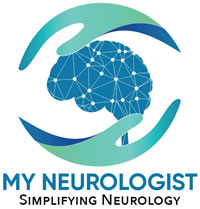Myotonic dystrophy or DM is a genetic disorder (resulting from abnormal genes) causing problems with muscles (mostly weakness), and many other organs (such as heart, lungs, brain, eyes).
What is myotonia?
It is a phenomenon when a contracted muscle does not relax and goes into a spasm. Patients with DM sometimes cannot let go of their hand while shaking with someone.
Are there different types of DM?
There are two types of DM: type 1, and type 2, each resulting from a different gene abnormality. For the type 1, the abnormality is on the chromosome 19 (expanded CTG triplet in DMPK), and for the type 2, the gene abnormality is on the chromosome 3 (expanded CCTG tetramer in CNBP). These genes are expressed in multiple organs (muscles, kidneys, central nervous system, heart, eye), which may cause problems in these areas. The pattern of inheritance for DM-1 is autosomal dominant, and gene expression may vary resulting in different severity of disease, sometimes appearing even before birth, while in some in their 60s. DM-2 can be asymptomatic or mild and is not considered a congenital disease.
What are symptoms and signs of DM?
Main symptom of DM is muscle weakness and cramps, involving limb muscles, mouth, and swallowing muscles. This result in difficulty speaking, difficulty talking, difficulty breathing, decreased facial expressions, arm and leg weakness, neck weakness, difficulty walking, and falls. Unlike muscular dystrophy where muscle weakness starts in the muscles closer to the body, shoulders, and pelvis, in DM, it involves muscles of hands and feet.
How is DM diagnosed?
Adult form of DM is diagnosed by its typical clinical features. In addition, electromyogram and nerve conduction studies may also help to make the diagnosis and rule out some related conditions.
What areas of body, other than skeletal muscles, may be involved in DM?
- Respiratory muscles, causing difficulty breathing, usually the cause of death.
- Cardiac, causing rhythm abnormalities or sudden death.
- Brain, causing dementia.
- Sleep, causing obstructive sleep apnea.
- Eyes, causing cataract and eye movement abnormalities.
- GI, causing dysphagia or difficulty swallowing.
- Metabolic, causing diabetes mellitus, or high cholesterol levels.
- Other, risk of cancer is increased in DM.
What is the treatment for DM?
No specific treatment is available. Meds are prescribed for symptoms, and complications are treated accordingly.
Where may I find more information about myotonic dystrophy?
American Association of Neuromuscular & Electrodiagnostic Medicine


Leave a Reply
Your email is safe with us.
You must be logged in to post a comment.